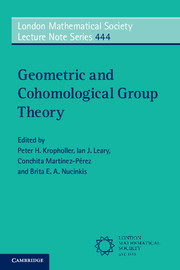Book contents
- Frontmatter
- Contents
- List of Participants
- Preface
- Obstructions for subgroups of Thompson's group V
- Groups of homological dimension one
- Braided diagram groups and local similarity groups
- On Thompson's group T and algebraic K-theory
- Special cube complexes (based on lectures of Piotr Przytycki)
- A hyperbolic group with a finitely presented subgroup that is not of type FP3
- The structure of Euclidean Artin groups
- Finitely presented groups associated with expanding maps
- On characteristic modules of groups
- Controlled algebra for simplicial rings and algebraic K-theory
- References
Controlled algebra for simplicial rings and algebraic K-theory
Published online by Cambridge University Press: 11 October 2017
- Frontmatter
- Contents
- List of Participants
- Preface
- Obstructions for subgroups of Thompson's group V
- Groups of homological dimension one
- Braided diagram groups and local similarity groups
- On Thompson's group T and algebraic K-theory
- Special cube complexes (based on lectures of Piotr Przytycki)
- A hyperbolic group with a finitely presented subgroup that is not of type FP3
- The structure of Euclidean Artin groups
- Finitely presented groups associated with expanding maps
- On characteristic modules of groups
- Controlled algebra for simplicial rings and algebraic K-theory
- References
Summary
Abstract
We develop a version of controlled algebra for simplicial rings. This generalizes the methods which lead to successful proofs of the algebraic K- theory isomorphism conjecture (Farrell-Jones Conjecture) for a large class of groups. This is the first step to prove the algebraic K-theory isomorphism conjecture for simplicial rings. We show that the category in question has the structure of a Waldhausen category and discuss its algebraic K-theory.
We lay emphasis on detailed proofs. Highlights include the discussion of a simplicial cylinder functor, the glueing lemma, a simplicial mapping telescope to split coherent homotopy idempotents, and a direct proof that a weak equivalence of simplicial rings induces an equivalence on their algebraic K-theory. Because we need a certain cofinality theorem for algebraic K-theory, we provide a proof and show that a certain assumption, sometimes omitted in the literature, is necessary. Last, we remark how our setup relates to ring spectra.
Introduction
Controlled algebra is a powerful tool to prove statements about the algebraic K-theory of a ring R. While early on it was used in [PW85] to construct a nonconnective delooping of K(R)—a space such that π i(K(R)) = Ki−1(R)—it is a crucial ingredient in recent progress of the so-called Farrell-Jones Conjecture. Our aim here is to construct for a simplicial ring R, and a so-called “control space” X, a category of “controlled simplicial R-modules over a X”. It should be regarded as a generalization of controlled algebra from rings to simplicial rings.
The category of “controlled simplicial modules” supports a homotopy theory which is formally very similar to the homotopy theory of CW-complexes. In particular we have a “cylinder object” which yields a notion of homotopy and therefore the category has homotopy equivalences. Waldhausen nicely summarized a minimal set of axioms to do homotopy theory in his notion of a Waldhausen category, called ’category with cofibrations and weak equivalences in [Wal85]. He did this to define algebraic K-theory of such a category. Our category satisfies Waldhausen's axioms, which is our main result:
Theorem.Let X be a control space and R a simplicial ring. The category of controlled simplicial modules over X, C(X;R), together with the homotopy equivalences and a suitable class of cofibrations is a “category with cofibrations and weak equivalences” in the sense of Waldhausen ([Wal85]). Therefore Waldhausen's algebraic K-theory of C(X;R) is defined.
- Type
- Chapter
- Information
- Geometric and Cohomological Group Theory , pp. 182 - 266Publisher: Cambridge University PressPrint publication year: 2017

